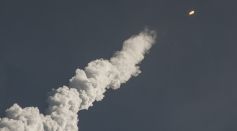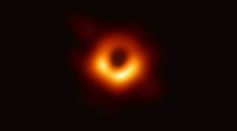SPACE

First Alien Message? Scientists To Simulate Extraterrestrial Signal From Mars, Send It to Earth

Japanese Moon Lander's Impact Site Found: NASA Lunar Orbiter Spotted Hakuto-R's Debris a Day After Its Failed Touchdown

James Webb Space Telescope Detects Water Vapor in the Asteroid Belt, Confirming the Origin of Oceans on Earth

Stunning Solar Close-Up Images Taken by Daniel K. Inouye Solar Telescope Showcase Intricate Details of the Sun
Auroras With Strange Behavior Captured in the Night Sky; What Caused Them to Pulsate and Tear Apart?

SpaceX Launches Axiom's Second Private Astronaut Mission to the International Space Station

China's Mysterious Craft Ejected an Unidentified Object Into Orbit That Disappeared Then Reappeared Later on, Report Reveals
Giant Coronal Mass Ejection From Sun’s Southern Hemisphere Could Hit Earth’s Magnetic Field, Cause Geomagnetic Storms
130-Foot Asteroid Approaching Earth at Savage Speed Over the Weekend
Experimental Spacecraft From China Returns From Orbital Mission; Experts Speculate About Possible Imitation of U.S. Spaceplane

Superheated Rings of Plasma That Mimic Accretion Disks Around Black Holes Created in the Laboratory
Astronomers Identify One Asteroid As Hazardous After Mapping Near-Earth Objects’ Path for the Next 1,000 Years
Amateur Rocket Deneb Breaks Record After Soaring 1.6 Times Higher Than Mount Everest
Volcanic Activity in an Exoplanet 90 Light-Years Away From Earth May Generate an Atmosphere
Most Popular

Can We Bring Back Extinct Animals? How De-Extinction Science and Technology Work

Why Do Stars Explode? Supernova Formation and the Final Stage of a Star Lifecycle

The Air Pollution Climate Link: What Environmental Science Reveals About Our Changing Planet

Extreme Heatwaves Explained: What Extreme Heat Science Reveals About Our Changing Climate




